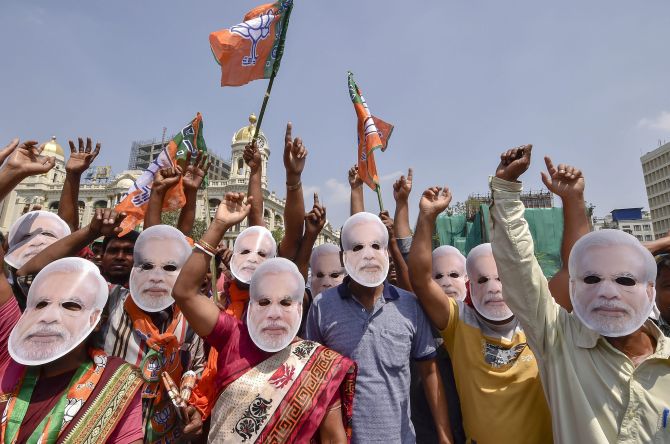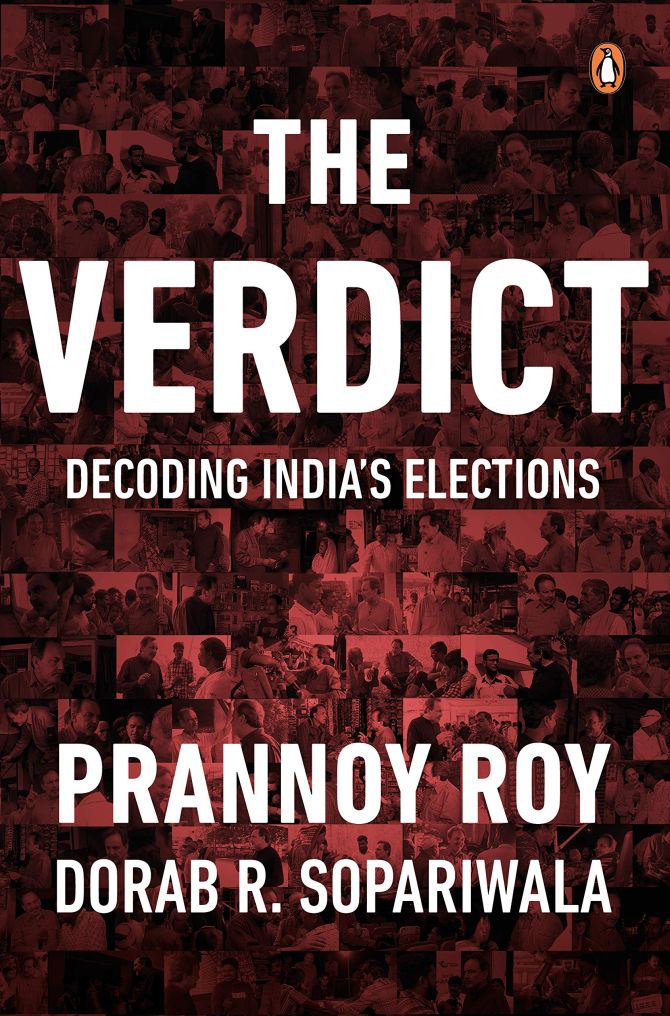 | « Back to article | Print this article |
'You've got to be a doer to be re-elected.'
'You don't have to be a great communicator or an orator any more because voters want to see action and development on the ground.'
'And they want a doer rather than just an orator.'

In The Verdict -- Decoding India's Elections, Dr Prannoy Roy and Dorab R Sopariwala, pioneers and arguably the best names in psephology in India, analyse databases of elections past and point out trends that will impact the 2019 Lok Sabha elections.
And they should know.
Dr Roy, as co-founder of the NDTV media group and Sopariwala, its editorial advisor and a market research veteran, have spent close to 40 years studying Indian elections and the electorate.
Published by Penguin Random House India, The Verdict is the go-to book for the largest exercise in democracy in the world.
"For an important issue to become an election issue, it has to fulfil two conditions -- one, the issue has to be important to me as a voter, and second, one party must be seen to be better than the other parties at solving the problem -- which is why sometimes issues like corruption don't become an election issue because all parties are believed to be equally corrupt," Dr Roy says.
Dr Roy and Sopariwala spoke to Rediff.com's Swarupa Dutt. Part 1 of a telephone interview.
How long has this book been in the making? How long did it take you to write it?
Prannoy Roy: Well, 20 years in the making; it's been at the back of one's mind and finally we took a year to actually write it.
Working till 3 am, like you prepare for an exam. Actually Dorab is much more disciplined. I am born and brought up under the Indian exam system in which we only work really hard before exams, right, and relax the rest of the year.
I still have the same need for a deadline. We had a deadline, which was that this book must come out before the elections, so that's how it finally happened.
It's a collaborative effort, so how do you decide who does what?
Prannoy: We have been working together for so many years so experiences are joint experiences. I mean we could exchange notes remotely -- everything is on the Internet now.
Whose voice runs through the book? Yours or Mr Sopariwala's?
Dorab R Sopariwala: Dr Roy's voice runs through the book.
While you were researching the book, what was the single biggest eye-opener for people like you who know everything there is to know about the Indian elections and the electorate?
Prannoy: Fortunately, the Election Commission has wonderful data, accessible freely to anybody. So just by analysing the data we learned so many things.
We understood elections in India and the voter much better by looking at the data.
Dorab: Yes, 50 or 60 per cent of the work was in the data, but it hadn't really been analysed or put together by party, by time period, by men and women. So, we learnt a lot.
So, are you in fact saying the data was available, but nobody really put it together cogently?
Prannoy: The data is absolutely available to anybody. It is on the Election Commission Web site and lot of people have used it and even developed other databases using the Election commission data like the (Trivedi) centre at Ashoka University. They have a wonderful Web site called Lok Dhaba with excellent data.
The foundation is the EC data and then we built on it. But there is a lot of other work that's been done already using that data.
But I do agree with you in the sense that psephology is an area with a lot of possibilities of further research and understanding in India.
We haven't included a lot in the book. Time and space constraints, and the deadline... so just wait for volumes II, III, IV and V.
Dorab: (Laughs) Oh no no, that's a nervous laugh.
No, seriously, are there more volumes to this book?
Dorab: You can churn out more from the database because it's so huge. There are endless possibilities and you have to decide what you want to do.
What was the single biggest fact that leapt out at you during your research?
Prannoy: I think getting the simple rules of Indian elections right.
For example, we all focus on whether there is a wave, or not, -- which is how popular is one party or the other -- but we forget that the importance of votes and popularity has declined rapidly in determining who wins Indian elections.
Today, we should look more at the index of Opposition unity. Are alliances in place or not. Don't focus only on the votes, instead alliances or lack of alliances are as important.
Dorab: Many of the Lok Sabha elections are a combination of landslides.
There is no neck-and-neck. There is only one neck, the neck that gets cut. Also regional parties are very important.

You say in your book that all politicians display one of the three skill sets -- thinker, fixer, communicator. Which politician has all the three skills -- living and dead?
Prannoy: None.
Dorab: Even two of the three characteristics are not very common, so scoring three out of three doesn't happen.
Prannoy: The voter has got wiser and just good oratory and communication skills are not essential to be re-elected.
You've got to be a doer to be re-elected.
Naveen Patnaik (four-term Odisha CM) is known as a doer, and not really for his oratory.
Similarly, Shivraj Singh Chouhan (three-term former Madhya Pradesh CM), Raman Singh (three-term former Chhattisgarh CM), Sheila Dikshit (three-term former Delhi CM) -- there are many like that who are examples that you don't have to be a great communicator or an orator any more because voters want to see action and development on the ground.
And they want a doer rather than just an orator.
Dorab: The term fixer is used in a positive manner, not fixing like fixing other people, but one who fixes the problem.
He is a doer because he fixes the problem when he seeks votes.
So nobody gets 3/3? What about Jawaharlal Nehru?
Prannoy: Look, Nehru is one of the best. But whether he had all three? I don't know.
The best leaders have had a bit of all three, but whether he gets 10/10 in all three, like for instance on economic growth -- I'm not sure.
You say that three terms is the most a government has been re-elected. Why have governments in Assam, Maharashtra, Himachal Pradesh been elected so many times over?
Prannoy: The dominant reason for a government to get elected for more than three terms, is actual work on development in villages, small towns and improving the life of people. Not oratory.
Dorab: There are some instances where there are historical reasons, like if you look at the CPM (Communist Party of India-Marxist) government in Bengal and Tripura. It took long years for the governments to be defeated.
In Bombay/Maharashtra, there was a Congress government from Independence until 1995, except for a brief two year period when Sharad Pawar bolted from the Congress and then returned to the fold.
This was probably because the Congress historically had very deep roots in the state, probably through its strong grip on the co-operatives in the state.
Historically, it is very difficult for a leader to offer the same vision again and again. Jyoti Basu himself got elected again and again.
In Maharashtra, there has been a seven time rise in women voters who are now 48% of the electorate or 4.2 crore of 8.7 crore voters. Would these numbers actually translate into turnout>
Prannoy: Women voter turnout going up so rapidly is the most heart-warming and uplifting thing about India's democracy.
In the state assembly elections in 1962 women voter turnouts was 20 per cent behind men, now it is higher than men.
Higher and higher participation by women in elections and in the democratic process is an absolutely wonderful phenomenon.
And, what's even more heart-warming is that rural women turnout is the highest among any group in the country -- higher than urban men, urban women and rural men.
So rural women are voting like never before and yes, they make a big difference to elections.
Do rural women vote according to the diktats of the man in the family?
Prannoy: All our field experience and the data and a survey by the CSDS ( Centre for the Study of Developing Societies) tells us that the woman voter today makes up her own mind. They vote independently without consulting their husbands.
This is even more true in the southern states than in the north.
You have said there are 30,000 missing voters per constituency. Why are they missing and why is there a north-south divide?
Prannoy: You're right. In the south, women are properly and fully registered; in many southern states there is 100 per cent registration.
The problem lies in the north and it's a terrible problem.
And the 30,000 missing women voters? That's an all India average, but if you take Uttar Pradesh, 85,000 women voters are missing in every single constituency. This is an unacceptable denial of a women's right to vote.
There is a thesis that needs to be written on this on the reasons why this is happening in India
We've talked to the Election Commission and we are convinced that they are trying their best.
The state administrations which actually get people registered on electoral rolls are male dominated institutions -- so the question is do they go to the women who are from poorest of poor, the scheduled caste areas in villages which are least accessible?
Do they use women officials to access Muslim women to ensure they are registered as voters.
Also there is a degree of social conservatism in certain sections of our society and a reluctance to have women photographed etc.
Many factors need to be understood and taken into account, but women being denied the right to vote is a travesty of our democracy and something needs to be done.

UP, Maharashtra, Rajasthan, Bihar, Madhya Pradesh have the largest number of women NOT registered to vote. A developed state like Maharashtra sits there like an anomaly, isn't it?
Dorab: It's a bit of a myth that Maharashtra is a developed state. I recall reading a report some years ago that if you remove the contribution of Mumbai from Maharashtra in terms of state GDP, Maharashtra would come 16th in the country in terms of per capita state GDP.
Mumbai dominates the economy of Maharashtra, so people think it's a wealthy state.
But it has a lot of tribal areas. When you talk about a developed state, you talk about financial muscle.
Mumbai, Pune, Nagpur, has financial muscle, but outside of these the financial muscle is not so great.
There is a lot of poverty in Maharashtra. The southern part of Madhya Pradesh is the tribal belt and it runs into Maharashtra, Gujarat, Odisha, Chhattisgarh.
There is a lot of poverty there. Where do you hear of the largest incidences of suicides? In Maharashtra, right!
We say Maharashtra is prosperous, but when you remove Bombay from it, it's not.
But that has nothing to do with registration of voters. Maharashtra is relatively more prosperous than some south Indian states. It has to do with literacy, education, social upliftment and things like that.
In Tamil Nadu, for instance, the DMK (Dravida Munnetra Kazhagam) has worked for social upliftment, for education, over the years and that is probably the reason why these are relatively more socially aware societies.